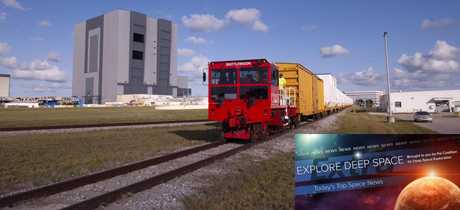In Today’s Deep Space Extra… NASA Administrator Jim Bridenstine sees a bright future for America in space. Kathy Lueders, NASA’s new human exploration chief, names Joel Montalbano as acting International Space Station (ISS) program manager to succeed the soon to retire Kirk Shireman.
Human Space Exploration
Boosters for first SLS Artemis Moon rocket arrive at KSC
Coalition Members in the News – Boeing, Lockheed Martin, Northrop Grumman, United Space Alliance
AmericaSpace.com (6/8): Northrop Grumman manufactured twin solid rocket boosters for the Artemis 1 Space Launch System (SLS) rocket have completed the first leg of their journey, traveling by rail from production facilities in Promontory, Utah, to NASA’s Kennedy Space Center (KSC) in Florida. Once the booster segments are joined and mated to the large rocket’s core and upper stage, the SLS it will take flight on Artemis 1, sending an uncrewed Orion crew capsule on a multi-week mission around the Moon for a return to Earth, a Pacific Ocean splashdown and recovery. Crews will board for a similar mission called Artemis 2. NASA intends to return to the surface of the Moon with human explorers aboard Artemis 3 in 2024.
Shuttle-flown solid rocket segments arrive in Florida for Artemis 1 SLS rocket
Coalition Member in the News – Northrop Grumman
Space.com (6/16): A solid rocket booster segment that helped launch the Hubble Space Telescope, send the space shuttle Endeavour on its maiden mission and return John Glenn to orbit has arrived back at NASA’s Florida spaceport to lift off once again — this time as part of the first Space Launch System (SLS) rocket. The steel cylinder, which will help form one of the two, five-segment motors to be mounted to the Artemis 1 SLS core stage, was among the hardware that was delivered by train to NASA’s Kennedy Space Center on Friday (June 12). The segments’ cross-country journey began seven days earlier at Northrop Grumman’s facility in Promontory, Utah, where the hardware had been serviced and loaded with the solid propellant that will provide more than 75% of the initial thrust for the planned 2021 uncrewed launch.
NASA ISS manager to retire
SpaceNews.com (6/17): Kirk Shireman, who has managed the International Space Station (ISS) program for NASA for five years, will retire later this month, the agency announced June 16. Shireman will leave the agency June 26 to take a position in the private sector, NASA said in a statement. Joel Montalbano, deputy ISS program manager, will take over as acting program manager on that date. “Kirk has dedicated 35 years of his career advancing and improving human spaceflight, and doing it in a collaborative way,” Kathy Lueders, the associate administrator for human exploration and operations, said in the statement. “I am confident Joel’s leadership of this program will continue to expand the role of the Space Station as a national asset for exploration, science, and commercial use.”
NASA to allow reuse of Crew Dragon spacecraft and boosters
Coalition Member in the News – Boeing
SpaceNews.com (6/16): NASA will allow SpaceX to reuse Crew Dragon spacecraft and the Falcon 9 first stages for launching them as soon as next year. A modification to the Commercial Crew Transportation Capability (CCtCap) contract NASA has with SpaceX, published last month, will allow SpaceX to reuse both the Falcon 9 first stage and Crew Dragon spacecraft starting with the second operational mission of the spacecraft, known as Post-Certification Mission (PCM) 2 or Crew-2. That change was described as part of a “bilateral modification” that also formally extended the length of the Demo-2 mission from two weeks to as long as 119 days. The move is a change for SpaceX, as the company originally planned to use a new Crew Dragon spacecraft on each of its commercial crew missions for NASA. That stood in contrast to Boeing, which will refurbish its CST-100 Starliner crew modules between flights.
Space Science
NASA’s OSIRIS-REx produces Nightingale mosaic
NASA/Goddard Space Flight Center (6/16): NASA’s Osiris-REx sample return mission science team has compiled a close-up image of Nightingale, the primary landing site for the spacecraft now orbiting the asteroid Bennu. Preparations are continuing for a planned brief contact with Bennu’s surface on October 20 to gather up pebbles and other surface material for return to Earth. On March 3, Osiris-REx departed its orbital perch to dip to 820 feet over Nightingale. The asteroids may help to explain how the Earth obtained its water and organics, the chemical building blocks for life.
See Earth and Venus from Mars in amazing photos from NASA’s Curiosity rover
Space.com (6/16): NASA’s Curiosity rover, which has been exploring Mars at Gale Crater since August 2012, offers images of the Earth and Venus from the Red Planet. Dust in the Martian atmosphere may be to blame for their appearance, more pinpoints of light than bright stars. Still, they are what a future human explorer from Earth might see when looking back toward home.
Op Eds
Space the jump start New Mexico’s economy needs
Santa Fe New Mexican (6/15): In an op ed, Casey Anglada DeRaad, founder and CEO of the nonprofit New Space New Mexico, urges citizen support for a growing global space economy, and an opportunity to share through the state hosted NASA facilities, Department of Energy national laboratories and Spaceport America.
Other News
Was there really a “mutiny” aboard the Skylab space station?
Astronomy.com (6/12): The answer to the headline question is not “mutiny,” but rather a “kerfuffle” in which the three first time astronauts assigned to the 83-day, final crew mission to NASA’s Apollo era, Skylab space station broke some ground on developing work schedules and expectations for efficiency. Given some latitude, the three member Skylab crew demonstrated increased efficiency.

